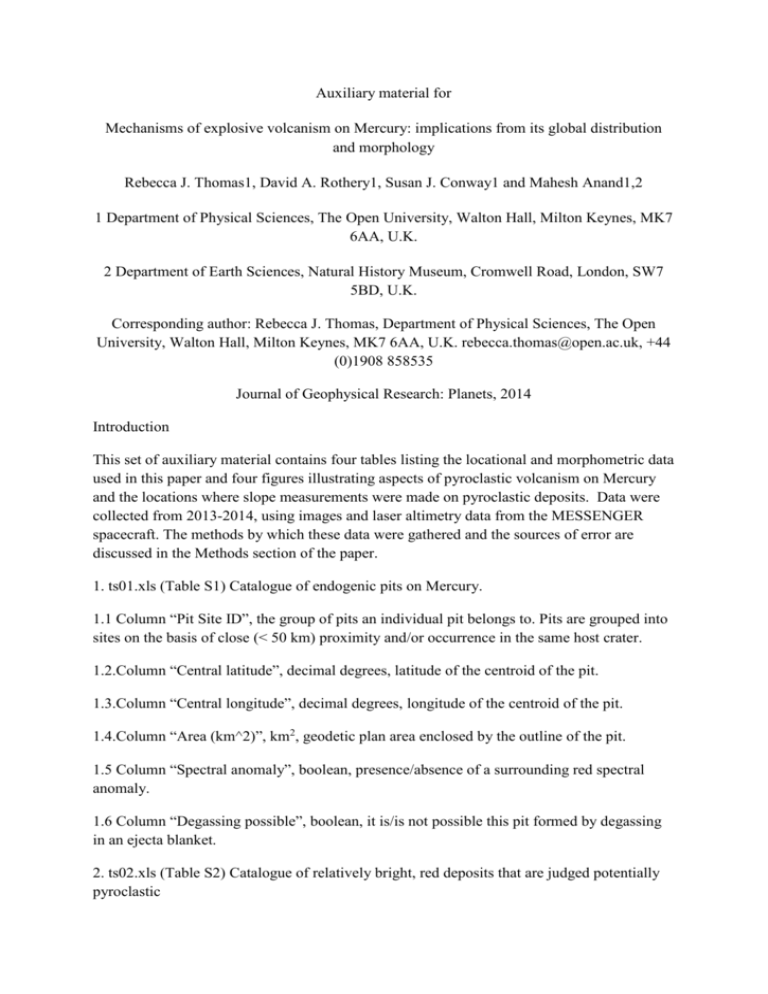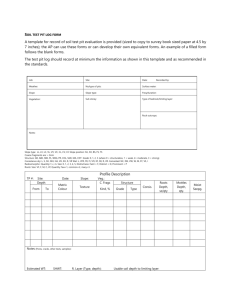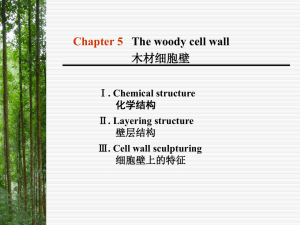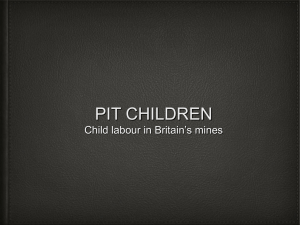read_me
advertisement

Auxiliary material for Mechanisms of explosive volcanism on Mercury: implications from its global distribution and morphology Rebecca J. Thomas1, David A. Rothery1, Susan J. Conway1 and Mahesh Anand1,2 1 Department of Physical Sciences, The Open University, Walton Hall, Milton Keynes, MK7 6AA, U.K. 2 Department of Earth Sciences, Natural History Museum, Cromwell Road, London, SW7 5BD, U.K. Corresponding author: Rebecca J. Thomas, Department of Physical Sciences, The Open University, Walton Hall, Milton Keynes, MK7 6AA, U.K. rebecca.thomas@open.ac.uk, +44 (0)1908 858535 Journal of Geophysical Research: Planets, 2014 Introduction This set of auxiliary material contains four tables listing the locational and morphometric data used in this paper and four figures illustrating aspects of pyroclastic volcanism on Mercury and the locations where slope measurements were made on pyroclastic deposits. Data were collected from 2013-2014, using images and laser altimetry data from the MESSENGER spacecraft. The methods by which these data were gathered and the sources of error are discussed in the Methods section of the paper. 1. ts01.xls (Table S1) Catalogue of endogenic pits on Mercury. 1.1 Column “Pit Site ID”, the group of pits an individual pit belongs to. Pits are grouped into sites on the basis of close (< 50 km) proximity and/or occurrence in the same host crater. 1.2.Column “Central latitude”, decimal degrees, latitude of the centroid of the pit. 1.3.Column “Central longitude”, decimal degrees, longitude of the centroid of the pit. 1.4.Column “Area (km^2)”, km2, geodetic plan area enclosed by the outline of the pit. 1.5 Column “Spectral anomaly”, boolean, presence/absence of a surrounding red spectral anomaly. 1.6 Column “Degassing possible”, boolean, it is/is not possible this pit formed by degassing in an ejecta blanket. 2. ts02.xls (Table S2) Catalogue of relatively bright, red deposits that are judged potentially pyroclastic 2.1 Column “Pit Site ID”, the Site ID of the pit(s) the deposit is associated with, as listed in Table S1 (ts01.xls). 2.2.Column “Deposit Area (km^2)”, km2, geodetic plan area covered by the spectral anomaly judged to be a pyroclastic deposit. 3. ts03.xls (Table S3) Endogenic pits for which we have obtained topographic data. 3.1 Column “Pit Site ID”, the group of pits an individual pit belongs to, as listed in Table S1 (ts01.xls). 3.2 Column “Pit/Host crater name”, name used to refer to the pit in the text, or, where the pit lies within a named crater, the crater name. 3.3 Column “Pit location in group”, locational identifier of the individual pit where a group consists of multiple pits. 3.4 Column “Depth (km)”, km, maximum depth of the pit below the local datum (e.g., the floor of the crater hosting the pit). 3.5 Column “Volume (km^2)”, km2, volume of the pit as calculated using the method indicated in column 3.6. 3.6 Column “Basis for volume calculation”, where a shape is indicated, an approximate volume was calculated by approximating the pit to that shape. Where DEM is indicated, volume was calculated in three dimensions from the pit rim using a DEM. 3.7 Column “Topographic data quality”, the quality of the highest quality data product derived for the pit, where: 5 = MLA track, 4 = DEM constrained by several MLA tracks, 3 = DEM constrained by a single MLA track, 2 = DEM unconstrained by MLA points (highest to lowest quality). 3.8 Column “Data source”, MESSENGER products from which the topographic data used to obtain depth/volume values were derived. Laser altimeter data products begin with ‘MLA’. MDIS narrow angle camera images with ‘EN’, and wide angle camera images with ‘EW’; these are stereo images, left then right. 4.ts04.xls (Table S4) Calculated slopes along cross-sections indicated in Figure S2. ‘na’ denotes not applicable. 4.1 Column “Pit Site ID”, the group of pits an individual pit belongs to, as listed in Table S1 (ts01.xls). 4.2 Column “Pit/Host crater name”, name used to refer to the pit in the text, or, where the pit lies within a named crater, the crater name. 4.3 Column “Slope (°)”, degrees, slope measured as the average between points at the top and bottom of the slope. 4.4 Column “Error (°)”, degrees, the error on the slope measurement (4.3). 4.5 Column “Slope length (km)”, km, horizontal distance between the points at the top and bottom of the slope. 4.6 Column “Slope height (m)”, m, vertical distance between the points at the top and bottom of the slope. 4.7 Column “Width from pit edge (km)”, km, horizontal distance between the pit edge and the point at the bottom of the slope. 4.8 Column “Pit margin”, location of the margin of the pit at which the slope measurement was taken. 4.9 Column “Anomaly Radius (km)”, km, the horizontal distance from the pit margin to the outer edge of any red spectral anomaly surrounding the pit along the same cross-section along which the slope was measured (if applicable). 4.10 Column “Topography width/Spectral anomaly width”, ratio between the values in 4.7 and 4.9. 4.11 Column “Topographic data quality”, the quality of the highest quality data product derived for the pit, where: 5 = MLA track, 4 = DEM constrained by several MLA tracks, 3 = DEM constrained by a single MLA track, 2 = DEM unconstrained by MLA points (highest to lowest quality). 4.12 Column “Data source”, MESSENGER products from which the topographic data used to obtain slope values in 4.3 were derived. Laser altimeter data products begin with ‘MLA’. MDIS narrow angle camera images with ‘EN’, and wide angle camera images with ‘EW’; these are stereo images, left then right. 5. fs01.jpg (Figure S1) The variety in cross-sectional shape of endogenic pits (no vertical exaggeration). Left images show the pit and the location of the DEM cross-section on the right side (white line). Stereo images are listed in Table S4. (a),(b) V- to U-shaped profile in a pit circumferential to an impact crater central peak (AP2, -135.5° E, -8.4° N); (c),(d) Flat floor and steep walls of a pit at the center of an impact crater (7038, -89.3° E, -21.1° N); (e),(f) Steep upper scarp in the east and smoothly-dipping floor of a large pit outside any impact crater (N Rachmaninoff, 57.4° E, 36.0° N). 6. fs02.pdf (Figure S2) Endogenic pits at which relief due to pyroclastic deposition, if present, should be visible in the topography, and our findings at each location. Numbered by pit site ID as listed in Table S1. Images: Left: Monochrome image of the pit and surrounding region orthorectified on the basis of a DEM derived from the stereo pair listed in Table S4 (except where indicated). White rectangle: extent of right image (where present). Right: Hillshade of the circum-pit area. Yellow outline: extent of a spectral anomaly suggesting the presence of pyroclastic deposits. White line: cross-section in the right column. Green line: surface trace of thrust fault. Cross-sections: Regions where slopes in Table S4 were calculated are indicated in red. Points: MLA points, lines: smoothed lines through DEM values. 7. fs03.pdf (Figure S3) The positive linear correlation between pit area and deposit area. 8. fs04.jpg (Figure S4) Small pits, possibly formed by post-impact degassing, in the rim and continuous ejecta of an unnamed crater (22.8⁰ E, 35.5⁰ N). (a) Relatively bright and red deposits (outlined in yellow) surround small pits (outlined in red). White rectangle: extent of (b). (Composite of EW0225101261I , EW0225101257G and EW0225101253F); (b) Closeup of the southwest pit (indicated by a white arrow), showing its uneven floor and irregular margin. Green arrows indicate nearby hollows (Image EN0220115477M).






